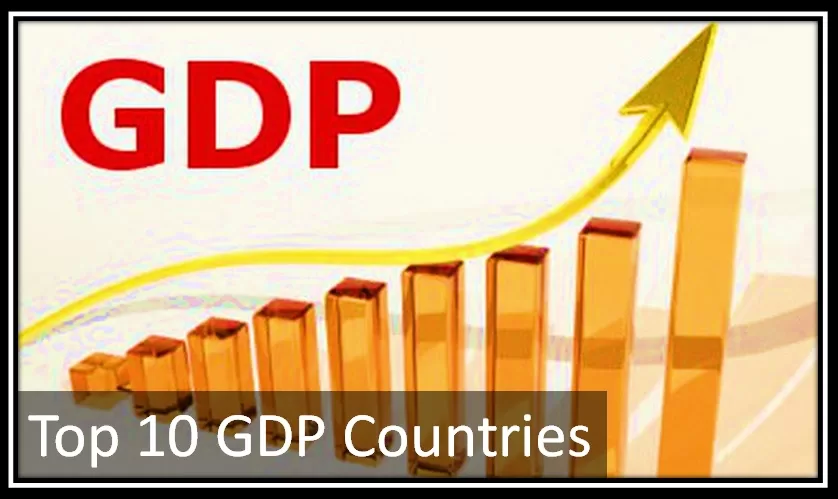Top 10 GDP Countries in 2023 – Countries with Highest GDPs in the World

In the world of economics, Gross Domestic Product (GDP) is one of the most important indicators of a country’s economic performance. It measures the total value of goods and services produced within a country’s borders in a given year. In 2023, the top 10 GDP countries include a mix of developed and developing nations. According to the International Monetary Fund (IMF), the United States is expected to remain the world’s largest economy followed by China, Japan, and Germany.
While the rankings may shift slightly, one thing is certain that these countries will continue to drive global economic growth and shape the future of the world economy. In this article, we’ll take a closer look at the top 10 GDP countries and their economic outlook in the year 2023.
10 Countries with the highest GDPs in the World in 2023
| Rank | Name of the country | Continent | Nominal GDP |
| 1 | United States of America (USA) | North America | 26.85 Thousand Billion US Dollars |
| 2 | China | Asia | 19.37 Thousand Billion US Dollars |
| 3 | Japan | Asia | 4.41 Thousand Billion US Dollars |
| 4 | Germany | Europe | 4.31 Thousand Billion US Dollars |
| 5 | India | Asia | 3.74 Thousand Billion US Dollars |
| 6 | United Kingdom | Europe | 3.16 Thousand Billion US Dollars |
| 7 | France | Europe | 2.92 Thousand Billion US Dollars |
| 8 | Italy | Europe | 2.17 Thousand Billion US Dollars |
| 9 | Canada | North America | 2.09 Thousand Billion US Dollars |
| 10 | Russia | Europe | 2.06 Thousand Billion US Dollars |
Top 10 Highest GDP Countries in 2023
USA – $26.85 trillion
The GDP of the United States of America (USA) is the largest in the world. In 2023, the country’s GDP is around $26.85 trillion. This is due to the country’s diverse economy which includes industries such as finance, healthcare, technology, and manufacturing.
The United States has been able to maintain its position as the world’s largest economy due to its strong economic policies and stable political environment. The country’s GDP has continued to grow steadily over the years with an average annual growth rate of 2.3% between 2010 and 2019.
However, the COVID-19 pandemic has had a significant impact on the country’s economy resulting in a decline in GDP by 3.5% in 2020. The government has implemented policies to support businesses and individuals during this challenging time and the economy is expected to recover gradually in the coming years.
China – $19.37 trillion
China’s GDP has been steadily increasing over the years making it the second-largest economy in the world. In 2023, China’s GDP is $19.37 trillion. It is over four times larger than it was in 2005. This growth can be attributed to various factors such as government policies, investments in infrastructure, and a large labour force.
The service sector is the largest contributor to China’s GDP accounting for more than half of the total output. The manufacturing sector is the second largest followed by agriculture. China is the world’s largest exporter of goods which has played a significant role in its economic growth. The country has also been investing heavily in renewable energy and technology which has helped to diversify its economy.
Despite its impressive economic growth, China still faces challenges such as income inequality, environmental issues, and an ageing population.
Japan – $4.41 trillion
Japan’s gross domestic product (GDP) is currently the third largest in the world behind the United States and China. In 2023, Japan’s GDP is approximately $4.41 trillion. The country’s economy is heavily reliant on exports, particularly in the automotive and electronics industries.
Looking forward, Japan’s economy is facing challenges such as an ageing population and a declining birth rate. However, the government has outlined a plan to achieve sustainable economic growth through innovation and investment in areas such as renewable energy and digital technology.
Germany – $4.31 trillion
Germany has the largest GDP in Europe and the fourth largest in the World. As of 2023, the GDP of Germany stands at approximately 4.31 trillion US dollars. The country’s economy is highly diversified with a strong focus on manufacturing, particularly in the automotive industry.
Germany has a highly skilled workforce and a strong education system which has contributed to its economic success. The country is also known for its high level of innovation and technological advancements. In recent years, Germany has made significant investments in renewable energy and has become a leader in the field.
Also Check
Most Powerful Courtiers in the World
List of Countries and their Parliaments
India – $3.37 trillion
India’s GDP has been steadily growing over the years. In 2023, it is around $3.37 trillion making it the fifth-largest economy in the world. The country’s economy is driven by a number of industries, including agriculture, manufacturing, and services.
Agriculture is a major contributor to India’s GDP, accounting for around 17% of the country’s economic output. Manufacturing is also an important part of the economy, with India producing a wide range of goods, including textiles, chemicals, and automobiles.
The service sector is the largest contributor to India’s GDP accounting for more than half of the country’s economic output. This includes everything from IT services and financial services to healthcare and education.
United Kingdom – $3.16 Trillion
The Gross Domestic Product (GDP) of the United Kingdom is one of the largest in the world, ranking sixth in the world according to the International Monetary Fund (IMF). In 2023, the UK’s GDP is approximately $3.16 Trillion.
The UK has a diversified economy that is driven by a mix of services, manufacturing, and agriculture. The services sector is the largest contributor to the UK’s GDP, accounting for around 80% of the country’s economic output. This includes industries such as finance, healthcare, retail, and entertainment. The manufacturing sector is also an important contributor to the UK’s GDP, with industries such as aerospace, automotive, and pharmaceuticals driving growth. The UK’s agricultural sector while smaller in scale still plays an important role in the country’s economy.
France – $2.92 trillion
The GDP of France is the largest in the European Union and the world. As of 2023, France’s GDP stands at approximately $2.92 trillion making it the seventh-largest economy in the world. However, the COVID-19 pandemic has had a significant impact on the French economy, causing a contraction of over 8% in 2020. Despite this setback, the French government has implemented measures to support businesses and individuals affected by the pandemic, such as financial aid and subsidies.
France’s economy is diverse with significant contributions from various sectors such as agriculture, manufacturing, and services. The country is the second-largest agricultural producer in Europe with food and beverage products accounting for a significant portion of its exports. France is also a global leader in several manufacturing industries such as aerospace, automobile, and luxury goods, among others.
Italy – $2.17 trillion
Italy is the eighth-largest economy in the world and the third-largest economy in the Eurozone with a GDP of $2.17 trillion in 2023. Italy is known for its manufacturing industry which is a major contributor to its economy. The country has a highly diversified manufacturing sector producing everything from luxury brands to high-tech goods. Italy is also a popular tourist destination.
The tourism industry is a significant contributor to Italy’s GDP generating over 13% of its total revenue. Agriculture is another important sector of the Italian economy especially in the southern regions where it employs a significant portion of the population.
Despite its economic strength, Italy has faced numerous economic challenges over the years including a high public debt-to-GDP ratio and a low rate of productivity growth. The country has also struggled with high youth unemployment, which has been a persistent problem in recent years.
Canada – $2.09 trillion
Canada is a developed country with a highly advanced economy and one of the highest standards of living in the world. The country boasts a diverse economy, with a mix of service manufacturing, and natural resource-based industries. The Canadian economy is the ninth largest in the world with a gross domestic product (GDP) of over $2.09 trillion.
Despite challenges such as the COVID-19 pandemic, Canada’s GDP has remained relatively stable. The country is expected to continue to be a strong player in the global economy in the years to come.
Russia – $2.06 trillion
As of 2023, Russia’s GDP is estimated to be around $2.06 trillion, making it the tenth largest in the world. Russia’s economy is highly dependent on its natural resources, especially oil and natural gas, which account for a significant portion of its exports. In addition, Russia has a highly skilled workforce, with a strong emphasis on science, engineering, and technology. The service sector including finance, retail, and hospitality has also grown in recent years contributing to a more diversified economy.
Frequently Asked Questions
A country can improve its GDP through investments in infrastructure, education, healthcare, and innovation.
Answer: Not necessarily. A high GDP can indicate a strong economy but it doesn’t necessarily mean that the wealth is distributed equally among citizens.
Answer: USA
Answer: Yes, a country’s GDP can change over time due to various factors such as economic growth, inflation, changes in government policies, and natural disasters.
Source: Wikipedia and other Sites




